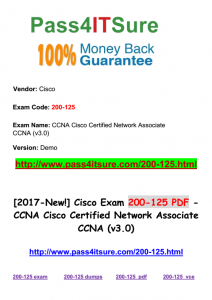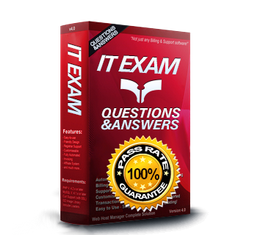In such society where all people take the time so precious, choosing Pass4itsure to help you pass the Cisco certification 200-125 dumps real Questions is cost-effective. Cisco version of new CCNA v3.0 https://www.pass4itsure.com/200-125.html dumps pdf Routing and Switching practice exam with the knowledge and skills on Dailymotion.
Exam Code: 200-125
Exam Name: CCNA Cisco Certified Network Associate CCNA (v3.0)
Updated: Aug 05, 2017
Q&As: 934
[2017 Latest Cisco 200-125 Dumps Version From Google Drive]: https://drive.google.com/open?id=0BwxjZr-ZDwwWT2VSaUVoODRKR1k
[2017 Latest Microsoft 70-741 Dumps Version From Google Drive]: https://drive.google.com/open?id=0BwxjZr-ZDwwWWU9QM0NyNGN1cFU

2017 Cisco 200-125 PDF (All 934 Q&As) from Pass4itsure:
Section 1: Sec One (1 to 48)
Detail:
Exercise Programming
QUESTION: 1
Which of the following is NOT an appropriate treatment activity for inpatient
rehabilitation of a client on the second day after coronary artery bypass graft (CABG)
surgery?
A. Limit activities as tolerated to the development of self-care activities, ROM for
extremities, and low-resistance activities.
B. Limit upper body activities to biceps curls, horizontal arm adduction, and overhead
press using 5-pound weights while sitting on the side of the bed.
C. Progress all activities performed from supine to sitting to standing.
D. Measure vital signs, symptoms, RPE, fatigue, and skin color and perform
electrocardiography before, during, and after treatments to assess activity tolerance.
200-125 exam Answer: B
QUESTION: 2
Which of the following situations indicates progression to independent and unsupervised
exercise for a client after CABG surgery in an outpatient program?
A. The client exhibits mild cardiac symptoms of angina, occurring intermittently during
exercise and sometimes at home while reading.
B. The client has a functional capacity of greater than 8 MET with hemodynamic
responses appropriate to this level of exercise.
C. The client is noncompliant with smoking cessation and weight loss intervention
programs.
D. The client is unable to palpate HR, deliver RPEs, or maintain steady workload
intensity during activity.
Answer: B
QUESTION: 3 Which of the following issues would you include in discharge education instructions for a
client with congestive heart failure to avoid potential emer- gency situations related to
this condition at home?
A. Record body weight daily, and report weight gains to a physician.
B. Note signs and symptoms(e.g., dyspnea, intolerance to activities of daily living), and
report them to a physician.
C. Do not palpate the pulse during daily activities or periods of light- headedness,
because an irregular pulse is normal and occurs at various times during the day.
D. Both A and B.
200-125 dumps Answer: D
QUESTION: 4
Initial training sessions for a person with severe chronic obstructive pulmonary disease
most likely would NOT include
A. Continuous cycling activity at 70% ofVo2max for 30 minutes.
B. Use of dyspnea scales, RPE scales, and pursed-lip breathing instruction.
C. Intermittent bouts of activity on a variety of modalities (exercise followed by short
rest).
D. Encouraging the client to achieve an intensity either at or above the anaerobic
threshold.
Answer: A
QUESTION: 5
Symptoms of claudication include
A. Cramping, burning, and tightness in the calf muscle, usually triggered by activity and
relieved with rest.
B. Acute, sharp pain in the foot on palpation at rest.
C. Crepitus in the knee during cycling.
D. Pitting ankle edema at a rating of 3 +
200-125 pdf Answer: A
QUESTION: 6
Treatment for claudication during exercise includes all of the following EXCEPT
A. Daily exercise sessions.
B. Intensity of activity to maximal tolerable pain, with intermittent rest periods.
C. Cardiorespiratory building activities that are nonweight bearing if the plan is to work
on longer duration and higher intensity to elicit a cardiorespiratory training effect.
D. Stopping activity at the onset of claudication discomfort to avoid further vascular
damage from ischemia.
Answer: D
QUESTION: 7
A client with angina exhibits symptoms and a 1mm, down-sloping ST- segment
depression at a HR of 129 bpm on his exercise test. His peak exercise target HR should
be set at
A. 128 bpm.
B. 109 to 119 bpm.
C. 129 bpm.
D. 125 to 128 bpm.
200-125 vce Answer: B
QUESTION: 8
Special precautions for clients with hypertension include all of the following EXCEPT:
A. Avoiding muscle strengthening exercises that involve low resistance.
B. Avoiding activities that involve the Valsalva maneuver.
C. Monitoring a client who is taking diuretics for arrhythmias.
D. Avoiding exercise if resting systolic BP is greater than 200 mm Hg or diastolic BP is
greater than 115 mm Hg.
Answer: A
QUESTION: 9
According to the most recent National Institutes of Health’s Clinical Guidelines for the
Identification, Evaluation, and Treatment of Overweight and Obesity in Adults,
recommendations for practical clinical assessment include
A. Determining total body fat through the BMI to assess obesity.
B. Determining the degree of abdominal fat and health risk through waist circumference.
C. Using the waist-to-hip ratio as the only definition of obesity and lean muscle mass.
D. Both A and B.
200-125 exam Answer: D
QUESTION: 10
A client with type 1 diabetes mellitus checks her fasting morning glucose level on her
whole-blood glucose meter (fingerstick method), and the result of 253 mgldL (14
mmol/L). A urine test is positive for ketones before her exercise session. What action
should you take?
A. Allow her to exercise as long as her glucose is not greater than 300 mgldL (17
mmol/L).
B. Not allow her to exercise this session, and notify her physician of the findings.
C. Give her an extra carbohydrate snack, and wait 5 minutes before beginning exercise.
D. Readjust her insulin regimen for the remainder of the day to compensate for the high
morning glucose level.
Answer: B
QUESTION: 11
A 62-year-old, obese factory worker complains of pain in his right shoulder on arm
abduction; on evaluation, decreased ROM and strength are noted. You also notice that he
is beginning to use accessory muscles to substitute movements and to compensate. These
symptoms may indicate
A. A referred pain from a herniated lumbar disk.
B. Rotator cuff strain or impingement.
C. angina.
D. Advanced stages of multiple sclerosis.
200-125 dumps Answer: B
QUESTION: 12
All of the following are special considerations inprescribing exercise for the client with
arthritis EXCEPT
A. The possible need to splint painful joints forprotection.
B. Periods of acute inflammation result in decreased pain and joint stiffness.
C. The possibility of gait abnormalities as compensation for pain or stiffness.
D. The need to avoid exercise of warm, swollenjoints.
Answer: B
QUESTION: 13
What common medication taken by clients with end-stage renal disease requires careful
management for those undergoing hemodialysis?
A. Antihypertensive medication.
B. Lithium.
C. Cholestyramine.
D. Cromolyn sodium.
200-125 pdf Answer: A
QUESTION: 14
Which of the following is an appropriate exercise for clients with diabetes and loss of
protective sention in the extremities?
A. Prolonged walking.
B. Jogging.
C. Step-class exercise.
D. Swimming.
Answer: D
QUESTION: 15
A client taking a calcium-channel blocker most likely will exhibit which of the following
responses during exercise?
A. Hypertensive response.
B. Increased ischemia.
C. Improved anginal thresholds.
D. Severe hypotension.
200-125 vce Answer: C
If you choose Pass4itsure, we promise that we will try our best to help you pass the 200-125 dumps exam and also provide you with one year free update service. If you fail the Pass4itsure https://www.pass4itsure.com/200-125.html dumps exam, we will give you a full refund.
